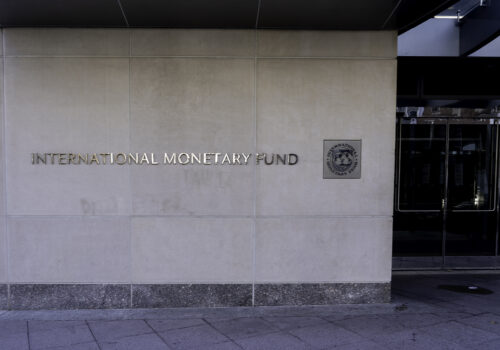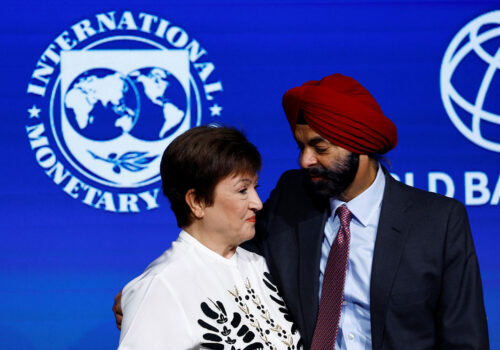Hawks vs. doves: The split between the Fed and the ECB
“’Too Late’ Powell must now LOWER THE RATE. He is unbelievable!!! Europe has lowered NINE TIMES!” This was President Trump’s reaction to the most recent European Central Bank (ECB) rate cut on June 5. Until then, the ECB had cut its main reference rate only seven times since its pandemic peak at 4.5 percent in September 2023. Yesterday, the Federal Reserve decided to hold rates steady, fueling monetary dispute between the White House and the US central bank.
After years of nearly aligned rate policies, the recent rate-cutting cycles of the United States and European Union (EU) central banks have recently not been in lockstep.
Following the most recent meeting, the current ECB reference rate stands at 2.15 percent. In her speech, ECB President Christine Lagarde explained the governors’ decision and suggested that the bank is nearing the end of its rate-cutting cycle.
In contrast, the US monetary authority has cut rates only three times since their peak of 5.5 percent in July 2023, bringing the benchmark rate down to 4.5 percent. Federal Reserve Chair Jerome Powell has defended the Fed’s cautious stance amid sharp criticism from President Trump, citing uncertainty with the administration’s tariff policy. With the now legally contested universal 10 percent tariff on nearly all US imports, the Fed is increasingly concerned about potential inflationary effects—leaving the Fed trailing behind its European counterpart in the rate-cutting cycle.
In the coming months, the Federal Reserve will have several opportunities to adjust or reinforce its hawkish monetary policy stance. But will it? Markets expect the Federal Open Market Committee to lower rates by fifty basis points by the end of the year, but judging by yesterday’s decision, we can anticipate continued vigilance. Setting tariffs aside, economic data from the Eurozone and the United States—particularly regarding central bank mandates such as price stability and sustainable employment—look strikingly similar. In both cases, inflation is gradually declining, and in the case of the ECB, it has already reached its 2 percent target. In April, US inflation stood at 2.1 percent, exceeding the Fed’s target by just 0.1 percentage point. Following the spike in unemployment after COVID-19—more pronounced in the United States due to differences in labor protection laws—employment remains historically strong in both regions, hovering around 6 percent in the EU and 4 percent in the United States. So, why is the ECB cutting rates while the Fed holds steady? If no cuts are made, Chair Powell will need to clearly communicate the Fed’s policy rationale.
It boils down to an uncertain economic outlook caused by recent shift in US trade policy. Amid a roller coaster of tariff announcements, it’s nearly impossible to assess their broader impact on the economy, inflation, and employment. Following Liberation Day and the dramatic reaction in the Treasury market, it seems that Trump’s tariff strategy does carry significant risk. Our Trump Tariff Tracker highlights how trade policy is being repurposed as a strategic lever. The most recent US–UK trade “deal” serves as a clear example of how tariffs are being used not just for protection, but as a starting point in broader negotiations—anchored by a proposed 10 percent baseline rate. Applying that framework to other agreements echoes Chairman Powell’s remark that “increases in tariffs this year are likely to push up prices and weigh on economic activity,” potentially delaying future monetary policy decisions.
But how long can the Fed afford to wait and see? According to the International Monetary Fund’s spring World Economic Outlook, US inflation in 2025 is projected to reach 3 percent. Moreover, the New York Fed conducts a survey measuring consumer inflation expectations, with the outlook for the next year currently at 3.2 percent—well above the Fed’s 2 percent target. Given elevated inflation expectations and lingering uncertainty—balanced against encouraging labor market and inflation data—the Fed will need to tread carefully. Cutting rates too soon could undermine recent progress in bringing inflation back to target and potentially necessitate future rate hikes. On the other hand, cutting rates too late could further weaken growth prospects and negatively impact employment.
Bart Piasecki is an assistant director at the Atlantic Council’s GeoEconomics Center.
Related content

At the intersection of economics, finance, and foreign policy, the GeoEconomics Center is a translation hub with the goal of helping shape a better global economic future.
Image: European Central Bank (ECB) President Christine Lagarde and U.S. Federal Reserve Board Chair Jerome Powell attend the ECB Forum on Central Banking in Sintra, Portugal, June 29, 2022. European Central Bank/Handout via REUTERS ATTENTION EDITORS - THIS IMAGE WAS PROVIDED BY A THIRD PARTY. NO RESALES. NO ARCHIVES



